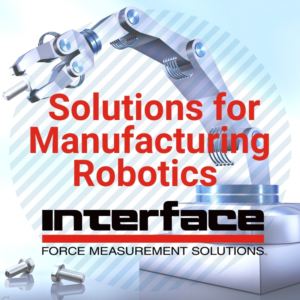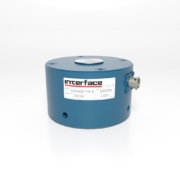Force Measurement Solutions for Advanced Manufacturing Robotics
 One of the most significant trends in advancing manufacturing is the use of robotics for smart factory automation. These types of machines are designed and coded to perform a variety of mundane and repetitive tasks on a manufacturing line or within an industrial facility. This allows humans to utilize their skills to work on more complex and productive tasks.
One of the most significant trends in advancing manufacturing is the use of robotics for smart factory automation. These types of machines are designed and coded to perform a variety of mundane and repetitive tasks on a manufacturing line or within an industrial facility. This allows humans to utilize their skills to work on more complex and productive tasks.
These activities are often characterized as picking, assembly, labeling, packaging, finishing work and inspection. Integrating robotics into manufacturing has many benefits including improved workplace safety, increasing productivity, and reducing material waste and costs. Interface uses robotics in our advanced manufacturing efforts in the assembly and building of world-class sensor technologies that are used around the world.
As with all points within a factory, there are many tasks that are very simple, while others can be very intricate requiring precision. As tasks become more difficult, the accuracy of the robot’s functionality is incredibly important. This is when sensors and precision measurement become instrumental to automation.
To ensure supreme accuracy, force measurement sensors are being used to improve processes as well as designed into robotic systems for monitoring performance data in real time. Force measurement sensors help manufacturers optimize the activities and tasks assigned to automated functions.
Popular types or robots used in advanced manufacturing environments using Interface load cells and our force measurement solutions include:
- Articulated – Often used in assembly, these robots have rotary joints to allow for a range of motion. Sensors such as mini or load button load cells are used in the testing and actual embedded in the joints to measure force and pressure.
- Gantry – These robots have three linear joints that move in different axes The X, Y, Z measurements are often tested with multi-axis load cells as this cartesian robot requires accuracy and precision.
- Cylindrical – This type of single robotic arm moves up and down, often stabilized by a cylindrical rod. They often are used in assemblies, welding, and handling of materials. These are tested with load cells for their ability to articulate the movement with exactness.
Interface products are playing a big role in manufacturing automation, especially in the design and development of robotics that use measurement in performance. They are used in all types of industries including automotive, medical, agriculture, and of course general manufacturing.
We supply a wide variety of sensors that measure force, torque, pressure, pulling force and more. We also are well-known worldwide for the accuracy and reliability of our products, making us the perfect fit for high-precision robotics applications.
Here are a few application examples where force measurement provides enormous value in testing and using robotics to advance manufacturing.
Industrial Robotic Arm in Production Line
Robotic arm solutions are becoming commonly used on production lines. When a manufacturer of a robot arm needed to measure force and torque when the arm picks up and places objects, Interface supplied a Model 6A40A 6-Axis Load Cell with Model BX8-HD44 Data Acquisition and Amplifier. The 6A40-6 Axis Load Cell was able to measure all forces and torques (Fx, Fʏ, Fz, Mx, Mʏ, Mz) and the BXB-HD44 Data Acquisition Amplifier was able to log, display, and graph these measurements while sending scaled analog output signals for these axes to the robot’s control system. This helped the customer optimize the multiple forces on the robot needed for moving objects on the production line. Read more about this solution here.
Robotic Arm
This customer needed to lift and move delicate objects, like a glass bottle, in an automated environment with a robotic arm without causing damage to the objects that are being lifted and moved. Delicacy was the key here. Two ConvexBT Load Button Load Cells were used in the grips of the robotic arm to measure the amount of pressure being applied to the object it is lifting and moving. The DMA2 DIN Rail Mount Signal Conditioner converts the signal received from the 2 ConvexBT Load Button Load Cells from mV/V to volts to the PLC Controller which tells the robotic arm to stop clamping pressure when a specified amount of pressure is applied to the object. The two ConvexBT Load Button Load Cells accurately measured the amount of pressure applied to the object the robotic arm was lifting and moving without causing any harm or damage to the object. Watch Robotic Arm Application Note and read more here.
More robotic applications are being tested every day. Interface is proud to be able to supply the necessary technology to enhance production lines, improve shipping and logistics operations and speed up repetitive processes with robotics so workforces can thrive and develop skills that advance manufacturing overall.
Additional Resources
OEM Industrial Robotic Arm App Note
Automation and Robotics Demands Absolute Precision
Robotics in Play with New Animated Application Using ConvexBT








